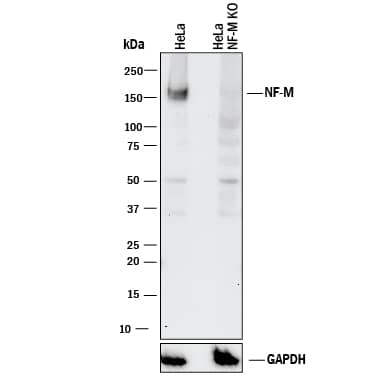NF-M Products
Neurofilaments are intermediate filaments that are major components of the neuronal cytoskeleton. Neurofilaments are composed of three subunits: the heavy subunit (NF-H), medium subunit (NF-M), and light subunit (NF-L). Neurofilaments are trimers that always contain the 68 kDa NF-L and variably contain 125 kDa NF-M and 200 kDa NF-H. The human neurofilament heavy chain is a phosphorylated cytoskeletal intermediate filament protein that is expressed in neurons. The neurofilament medium subunit Human NF-M is a phosphorylated glycoprotein that belongs to the type IV intermediate filament family. NF-L is a 68 kDa light chain cytoskeletal intermediate filament protein that associates with the 125 kDa NF-M and the 200 kDa NF-H to form neurofilaments.
All three neurofilament subunits share a common structure, with globular head, alpha-helical rod, and carboxy terminal side-arm domains. The subunits assemble to form 10 nm neurofilaments. Accumulation of neurofilaments is seen in several human diseases including amyotrophic lateral sclerosis (ALS), Parkinson's disease, Alzheimer's disease, and diabetic neuropathy.
116 results for "NF-M" in Products
116 results for "NF-M" in Products
NF-M Products
Neurofilaments are intermediate filaments that are major components of the neuronal cytoskeleton. Neurofilaments are composed of three subunits: the heavy subunit (NF-H), medium subunit (NF-M), and light subunit (NF-L). Neurofilaments are trimers that always contain the 68 kDa NF-L and variably contain 125 kDa NF-M and 200 kDa NF-H. The human neurofilament heavy chain is a phosphorylated cytoskeletal intermediate filament protein that is expressed in neurons. The neurofilament medium subunit Human NF-M is a phosphorylated glycoprotein that belongs to the type IV intermediate filament family. NF-L is a 68 kDa light chain cytoskeletal intermediate filament protein that associates with the 125 kDa NF-M and the 200 kDa NF-H to form neurofilaments.
All three neurofilament subunits share a common structure, with globular head, alpha-helical rod, and carboxy terminal side-arm domains. The subunits assemble to form 10 nm neurofilaments. Accumulation of neurofilaments is seen in several human diseases including amyotrophic lateral sclerosis (ALS), Parkinson's disease, Alzheimer's disease, and diabetic neuropathy.
| Reactivity: | Human, Mouse, Rat, Bovine, Porcine, +4 More |
| Details: | Chicken IgY Polyclonal |
| Applications: | IHC, WB, ICC/IF, KD |
| Reactivity: | Human, Mouse, Rat, Bovine, Porcine, +2 More |
| Details: | Rabbit IgG Polyclonal |
| Applications: | IHC, WB, ICC/IF, KO |
| Reactivity: | Human, Mouse, Rat, Bovine, Porcine, +2 More |
| Details: | Mouse IgG1 Monoclonal Clone #3H11 |
| Applications: | IHC, WB, ICC/IF |
| Reactivity: | Human |
| Details: | Sheep IgG Polyclonal |
| Applications: | WB, IHC, KO |
| Reactivity: | Human |
| Details: | Rabbit IgG Polyclonal |
| Applications: | IHC, WB, ICC/IF |
| Reactivity: | Human, Mouse, Rat |
| Details: | Mouse IgG1 Monoclonal Clone #CL2688 |
| Applications: | IHC, WB |
| Reactivity: | Human |
| Details: | Mouse IgG1 Monoclonal Clone #327921 |
| Applications: | WB, KO |
Recombinant Monoclonal Antibody.
| Reactivity: | Human, Mouse, Rat |
| Details: | Rabbit IgG Monoclonal Clone #JM11-20 |
| Applications: | IHC, WB, ICC/IF, IP |
| Reactivity: | Human, Mouse |
| Details: | Rabbit IgG Polyclonal |
| Applications: | IHC, WB, ICC/IF |
| Reactivity: | Human, Mouse, Rat, Bovine, Porcine, +2 More |
| Details: | Mouse IgG1 Monoclonal Clone #MCA-3H11 |
| Applications: | IHC, WB, ICC/IF |
| Reactivity: | Human |
| Details: | Mouse IgG1 Monoclonal Clone #OTI2G3 |
| Applications: | IHC, WB |
Recombinant Monoclonal Antibody
| Reactivity: | Human |
| Details: | Rabbit IgG Monoclonal Clone #5E0D2 |
| Applications: | WB, ICC/IF |
| Reactivity: | Human, Mouse, Rat |
| Details: | Mouse IgG2A Monoclonal Clone #CL2697 |
| Applications: | IHC, WB |
| Reactivity: | Human |
| Details: | Mouse IgG1 Monoclonal Clone #OTI2G3 |
| Applications: | IHC, WB |
| Reactivity: | Human, Mouse, Rat |
| Details: | Mouse IgG2B Monoclonal Clone #CL2705 |
| Applications: | IHC, WB |
| Reactivity: | Human, Mouse, Rat |
| Details: | Mouse IgG2B Monoclonal Clone #CL2705 |
| Applications: | IHC, WB |
| Reactivity: | Human, Mouse, Rat |
| Details: | Mouse IgG2B Monoclonal Clone #CL2705 |
| Applications: | IHC, WB |
| Reactivity: | Human, Mouse, Rat |
| Details: | Mouse IgG1 Monoclonal Clone #CL2688 |
| Applications: | IHC, WB |
| Reactivity: | Human, Mouse, Rat |
| Details: | Mouse IgG1 Monoclonal Clone #CL2678 |
| Applications: | IHC, WB |
| Reactivity: | Human, Mouse, Rat |
| Details: | Mouse IgG1 Monoclonal Clone #CL2688 |
| Applications: | IHC, WB |
| Reactivity: | Human, Mouse, Rat |
| Details: | Mouse IgG1 Monoclonal Clone #CL2678 |
| Applications: | IHC, WB |
| Reactivity: | Human |
| Details: | Mouse IgG1 Monoclonal Clone #OTI2G3 |
| Applications: | IHC, WB |
| Reactivity: | Human |
| Details: | Mouse IgG1 Monoclonal Clone #OTI2G3 |
| Applications: | IHC, WB |
| Reactivity: | Human |
| Details: | Mouse IgG1 Monoclonal Clone #OTI2G3 |
| Applications: | IHC, WB |

![Western Blot: NF-M Antibody [NB300-222] Western Blot: NF-M Antibody [NB300-222]](https://resources.bio-techne.com/images/products/NF-M-Antibody-NB300-222-img0004.jpg)
![Western Blot: NF-M Antibody [NB300-133] Knockout Validated: NF-M Antibody [NB300-133]](https://resources.bio-techne.com/images/products/NF-M-Antibody-Knockout-Validated-NB300-133-img0010.jpg)
![Western Blot: NF-M Antibody (3H11) [NB300-134] Western Blot: NF-M Antibody (3H11) [NB300-134]](https://resources.bio-techne.com/images/products/NF-M-Antibody-3H11-Western-Blot-NB300-134-img0004.jpg)


![Immunohistochemistry-Paraffin: NF-M Antibody [NBP1-87754] Immunohistochemistry-Paraffin: NF-M Antibody [NBP1-87754]](https://resources.bio-techne.com/images/products/NF-M-Antibody-Immunohistochemistry-Paraffin-NBP1-87754-img0013.jpg)
![Western Blot: NF-M Antibody (CL2688) [NBP2-46618] Western Blot: NF-M Antibody (CL2688) [NBP2-46618]](https://resources.bio-techne.com/images/products/NF-M-Antibody-2688-Western-Blot-NBP2-46618-img0009.jpg)

![Western Blot: NF-M Antibody (JM11-20) [NBP2-66978] Western Blot: NF-M Antibody (JM11-20) [NBP2-66978]](https://resources.bio-techne.com/images/products/NF-M-Antibody-JM11-20-Western-Blot-NBP2-66978-img0003.jpg)
![Immunohistochemistry-Paraffin: NF-M Antibody [NBP1-87753] Immunohistochemistry-Paraffin: NF-M Antibody [NBP1-87753]](https://resources.bio-techne.com/images/products/NF-M-Antibody-Immunohistochemistry-Paraffin-NBP1-87753-img0014.jpg)
![Western Blot: NF-M Antibody (MCA-3H11) [NBP2-31206] Western Blot: NF-M Antibody (MCA-3H11) [NBP2-31206]](https://resources.bio-techne.com/images/products/NF-M-Antibody-MCA-3H11-Western-Blot-NBP2-31206-img0003.jpg)
![Western Blot: NF-M Antibody (OTI2G3) [NBP2-46139] Western Blot: NF-M Antibody (OTI2G3) [NBP2-46139]](https://resources.bio-techne.com/images/products/NF-M-Antibody-2G3-Western-Blot-NBP2-46139-img0010.jpg)

![Western Blot: NF-M Antibody (5E0D2) [NBP3-15655] Western Blot: NF-M Antibody (5E0D2) [NBP3-15655]](https://resources.bio-techne.com/images/products/NF-M-Antibody-5E0D2-Western-Blot-NBP3-15655-img0002.jpg)
